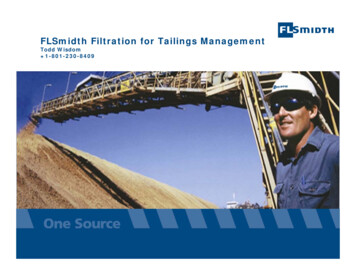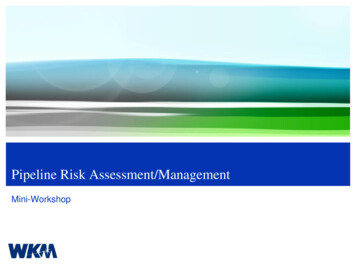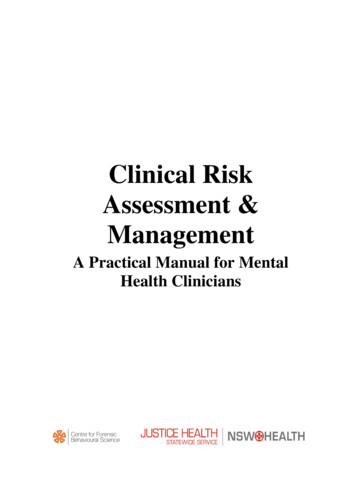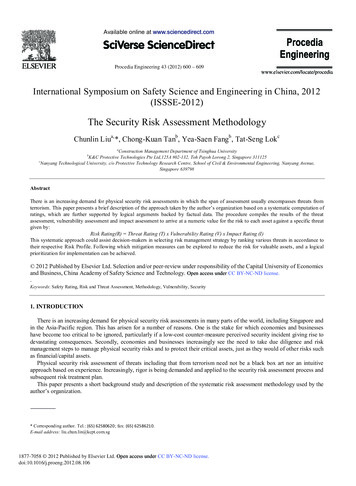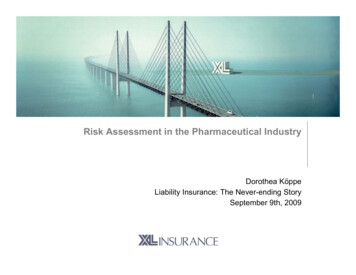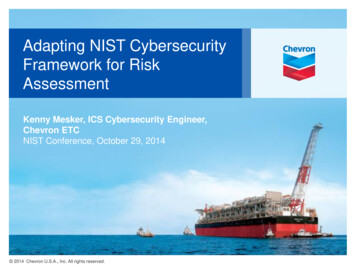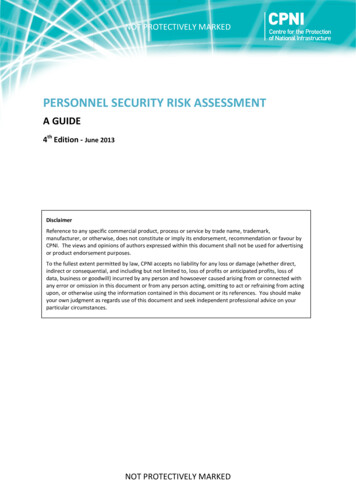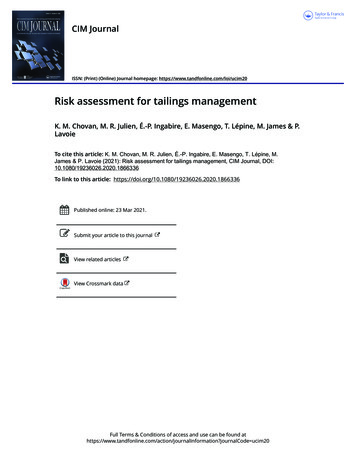
Transcription
CIM JournalISSN: (Print) (Online) Journal homepage: https://www.tandfonline.com/loi/ucim20Risk assessment for tailings managementK. M. Chovan, M. R. Julien, É.-P. Ingabire, E. Masengo, T. Lépine, M. James & P.LavoieTo cite this article: K. M. Chovan, M. R. Julien, É.-P. Ingabire, E. Masengo, T. Lépine, M.James & P. Lavoie (2021): Risk assessment for tailings management, CIM Journal, DOI:10.1080/19236026.2020.1866336To link to this article: shed online: 23 Mar 2021.Submit your article to this journalView related articlesView Crossmark dataFull Terms & Conditions of access and use can be found ation?journalCode ucim20
ENVIRONMENTAL AND SOCIAL RESPONSIBILITY1Risk assessment for tailings managementK. M. ChovanEnviro Integration Strategies Inc., Saskatoon, CanadaM. R. Julien, É.-P. Ingabire, E. Masengo, T. Lépine, M. James, and P. LavoieAgnico Eagle Mines Limited, Toronto, 6ABSTRACT Due to the severity of several major failures, the mining industry has significantlyincreased efforts to improve the design, construction, operation, monitoring, and management oftailings storage facilities (TSF). Best practice guidance mandates strong governance by senior execu tives, multi-tiered management systems, external third-party review, and the application of risk assess ment to all TSF design, operation, and management activities. Tailings may be produced in slurry,thickened, or filtered form, and every TSF has its own unique site characteristics, design, and opera tional conditions, presenting various forms and levels of risk. Companies with large TSF portfoliosmust compile complex information in a manner that allows differentiation, prioritization, and commu nication of the risks to various stakeholders. This article updates a novel and rational tool to assess therisks associated with TSF. The tool provides the means of communicating these risks, and of prioritiz ing corrective actions. It also facilitates the implementation of risk-based management practices whileallowing consideration of the unique conditions of a company, its organizational structure and internalpractices, as well as the varied nature and characteristics of its TSF portfolio.KEYWORDS Factor of safety, Level of engineering, Probability of failure, Risk assessment, Tailings managementRÉSUMÉ En raison de la gravité de plusieurs défaillances majeures, l’industrie minière aconsidérablement accru ses efforts pour améliorer la conception, la construction, l’exploitation, lasurveillance et la gestion des sites d’entreposage des résidus miniers (ERM). Les lignes directricessur les pratiques exemplaires exigent une solide gouvernance de la part des cadres supérieurs, dessystèmes de gestion à plusieurs niveaux, un examen externe par des tiers et l’application de l’évaluationdes risques à toutes les activités de conception, d’exploitation et de gestion de l’ERM. Les résidusminiers peuvent être produits sous forme de boue, épaissis ou filtrés, et chaque ERM a ses proprescaractéristiques de site, sa conception et ses conditions d’exploitation, ce qui présente diverses formeset divers niveaux de risque. Les sociétés ayant de grands portefeuilles d’ERM doivent compiler desrenseignements complexes de manière à permettre la différenciation, l’établissement des priorités et lacommunication des risques aux divers intervenants. Cet article met à jour un outil nouveau et rationnelpour évaluer les risques associés à l’ERM. L’outil permet de communiquer ces risques et de prioriser lesmesures correctives. Il facilite également la mise en œuvre de pratiques de gestion axées sur les risquestout en tenant compte des conditions uniques d’une entreprise, de sa structure organisationnelle et de sespratiques internes, ainsi que de la nature et des caractéristiques variées de son portefeuille d’ERM.MOTS-CLÉS évaluation des risques, facteur de sûreté, gestion des résidus miniers, niveau d’ingénierie,probabilité de défaillanceINTRODUCTIONThe Mining Association of Canada (MAC) recentlyupdated its Toward Sustainable Mining program andexpects all of its members to implement the program intheir operations. The program is adaptable to apply toa broad range of organizational structures, mining activ ities, and regulatory environments. MAC also updated itsGuide to the Management of Tailings Facilities (MiningCIM Journal Vol. 00, No. 00, 2021
2K. M. Chovan, M. R. Julien, É.-P. Ingabire, E. Masengo, T. Lépine, M. James and P. LavoieAssociation of Canada, 2019), maintaining a strongemphasis on management systems, clarity of roles andresponsibilities, and risk management. In particular, theTailings Guide mandates as follows: A solid and flexible governance model for tailingsmanagement; A strong emphasis on a risk-based approach; A focus on Best Available Technology (BAT) and BestAvailable/Applicable Practices (BAP); and, The identification of critical controls and their imple mentation as performance monitoring indicators.Larger mining companies typically maintain a portfoliowith numerous and very diverse tailing storage facilities(TSF). This diversity can stem from differing ore bodiesand mineralogy, ore processing, climate, environment,operating conditions, and regulations. Tailings can consistof conventional slurry, thickened or filtered, and are storedin TSF of different type and design—from recent designand construction to those that have been evolving overdecades. Finally, alongside and somewhat analogous interms of risks to TSF, there are other critical infrastructuressuch as heap leach facilities, waste rock storage facilities,and water management infrastructure.This article presents a comprehensive risk assessmentmethod developed for the management of TSF. The pro cess includes an empirical method to estimate the annualprobability of failure that is then combined witha quantitative evaluation of the consequences of failureto produce an objective and detailed assessment of therisk. It was developed to improve internal communicationand documentation of the risks of critical infrastructure,and to facilitate transparent risk-based decision-making.The method integrates MAC’s Tailings Guide (2019)intent and requirements into the complex operating reali ties of TSF management. While the following discussionfocuses on TSF, the method has also been applied, withsome modifications, to other critical infrastructure.Governance and a risk-based approachHistorically, the mining industry has not treated minewaste management as a core business activity. It wasconsidered peripheral and was typically deferred to exter nal consultants or contractors. However, in the last 5 to10 years, a significant shift has occurred. As mentioned byJulien (2016a, 2016b), mine waste management is nowviewed as a core activity of the mining industry to thesame extent as excavating and processing ore. Companiesare now more explicitly influencing the outcomes of wastemanagement by increasing in-house capabilities, havingmore direct involvement in the design activities, and byimproving the linkage with the production.MAC’s updated Tailings Guide (2019) mandatesa governance policy that places responsibility for tailingsmanagement with the Owner (i.e., the Board of Directors)and it is expected that an Accountable Executive Officer(AEO) be designated for tailings management. The AEOmust be aware of the key outcomes of TSF risk assessmentsand how these risks are managed, has accountability andresponsibility for developing an appropriate managementstructure, and provides assurance to the Owner and otherstakeholders.MAC’s Tailings Guide (2019) also explicitly mandatesthe notion of risk-based approach as an important build ing block of a well-functioning tailings managementsystem. However, conventional risk analysis, where riskis expressed as a product of the probability of occurrencetimes the consequence of its failure (InternationalElectrotechnical Commission, 2009), is particularly chal lenging for TSF where the frequency of occurrence is lowto very low, and consequences are high to very high. Bysuch traditional approaches, many TSF are rated at simi lar levels, low to medium risk, making it difficult todifferentiate where priorities exist and to utilize the infor mation in planning and decision-making. This aspect hasbeen pointed out in several publications (Caldwell et al.2015; Oboni & Oboni, 2016). Additionally, the TailingsGuide promotes a shift in decision making for tailingsmanagement toward the Owner level. Thus, clarificationand quantification of the relative risks associated withcritical infrastructure is necessary.Conventional risk analyses do not support the level ofsophistication needed to have a meaningful risk-basedapproach for such high consequence infrastructure, in parti cular where design, construction, and operation may havespanned over several decades. An additional challenge withapplying a conventional risk analysis comes from the verystrong influence of highly technical matters and the link withthe complex life cycle of these facilities, which are com monly progressively designed and constructed while beingoperated. Communication of the risks of complex technicalaspects is very complicated, and include considerations asso ciated with the combination of static liquefaction, post-peakand post-liquefaction behaviour, residual strength para meters, tailings dam classification, dam breach analysis, etc.Senior management, operators and other stakeholders oftendo not have the technical background to appreciate the subtle ties of these phenomena and their interaction with TSF per formance and stability.Risk assessment serves the following two main pur poses: (1) as a means of communicating the leveland nature of risks associated with specific TSF and theTSF portfolio to management from mine operation to own ership level as well as other stakeholders; and (2)to provide detailed, quantitative data that can be used toprioritize risk management measures that correspond toactionable elements of design, construction, operation,and monitoring.The next sections describe the development and appli cation of a simple yet robust risk assessment tool, specifi cally designed for compiling information, then measuring,CIM Journal Vol. 00, No. 00, 2021
Risk assessment for tailings managementunderstanding, and communicating relative levels of riskfor complex critical mine infrastructure whose design andconstruction evolve over an extended period of time. Thecompilation of information for an entire TSF portfolioensures transparency, provides clarity, and supports theability to differentiate and delineate priorities for mana ging risks within a TSF portfolio.THE PROBABILITY OF FAILUREThe published work of Silva, Lambe, and Marr (2008)was selected as the foundation for the development of therisk assessment method presented here. Using data fromactual geotechnical engineering infrastructure thatincluded dams, natural and constructed slopes, earthretaining structures, and tailings dams, Silva, Lambe andMarr (2008) developed empirical relationships betweenannual probability of failure (APF), factor of safety (FS),and Level of Engineering (LOE), referred to here as theSilva Method. The relationships are shown on Figure 1.The FS used is that for the static condition.The LOE was determined through systematic evaluationof five categories of engineering as follows: (1) DesignInvestigation, (2) Design-Laboratory Testing, (3) DesignAnalysis, (4) Construction, and (5) Operation &Monitoring. For each category, the structures were evaluatedagainst a set of criteria, based on levels of compliance. Forexample, full compliance on all criteria in a category wouldscore as Level I (Best), and as the degree of compliancedecreased, the assigned level would decrease to as low asLevel IV (Poor). The structures were then classified overallas Level I, II, III, or IV, respectively indicating Best, AboveAverage, Average, or Poor, by summing an equally weightedscore from each category. The Silva Method is a powerfultool to communicate probabilities of failure to technicalexperts, non-technical professionals, and stakeholders.This method was selected as a basis for several reasons.It was developed from case histories for earthfill structuresthat have similar construction methods and failuremechanisms as TSF dikes. It includes the LOE analysesthat recognize that the quality and degree of uncertainty indesign and construction, as well as in operation and mon itoring, can directly influence the probability of failure fora given FS. Though the state of practice, regulations, andguidelines are strongly driven by a deterministic view ofthe FS, using APF is seen as a much more palatableconcept to non-experts. As discussed in Duncan (2000)and Herzal, Ashley, and Thorp (2017), the FS containsan inherent notion of uncertainty. As will be shown, thisuncertainty is captured in the LOE.This method leads to the estimation of a realistic APFbased on quantifiable and related parameters, the FS andthe LOE. The interaction of these three parameters is quiteinteresting and can be quite useful. For example, whencomparing two structures using such an approach,3a structure with higher FS and higher APF demonstratesbetter stability in terms of the deterministic FS but is morelikely to fail than the other in a given period. So, it couldbe prioritized for mitigation work or more stringent mon itoring that would lead to an increase in the FS or LOE,and thus lower the APF. This aspect will be demonstratedin the results presented here.As noted, this methodology uses the static FS. This isconsidered reasonable given that the knowledge base andexperience for this condition are solid and well estab lished. Although more complex failure mechanisms (e.g.,strain softening) are not explicitly included, it is assumedthat the Best LOE considers all of the potential failuremechanisms for a particular structure and that lower LOEmay not have considered some of these mechanisms–increasing the degree of uncertainty and the APF.In the context of risk assessment, failure is defined as anevent that would trigger the assumed consequences. Theremust be agreement between the failure and the conse quences. For example, an event that does not result inthe release of tailings could be defined as a failure ina general context but might not initiate the consequencesconsidered in the risk assessment. Such an event shouldnot be considered in the risk assessment.MODIFICATION OF THE SILVA METHODThe Silva Method was modified to account for thecomplexities of the phased design and construction andcontinuous operation of TSF over many years, observa tions of performance, and changes in engineering practice,as well as to facilitate computerized calculation. Thesemodifications are described below.Determination of the annual probability of failureMinor adjustments were made to the existing APF vs.FS relationships, creating simpler straight-line interpreta tions in semi-logarithmic space. Additionally, minimumswere applied to the LOE. For Levels I, II, III, and IV, theAPF were derived using best-fit lines, drawn through theexisting data sets of Silva, Lambe, and Marr (2008). Forthe mid-level relationships (Ib, IIb, and IIIb), the APFwere mathematically interpolated from adjacent levels.These modified relationships, the mid-level interpretationsand the original Silva relationships are presented inFigure 2.As shown in the figure, the adjustments had minoreffects on the relationships, except for adding conserva tism for Level I APFs between FS 1.2 and 1.8. The midlevel relationships were created to reduce the gaps betweenthe APF for different LOE, which exceeded two orders ofmagnitude. For example, for an infrastructure with an FSof 1.8, the APF decreases from 2 10 6 to 1 10 3 for anLOE II and III, respectively. The mid-level relationshipswere applied in the following manner: for anyCIM Journal Vol. 00, No. 00, 2021
4K. M. Chovan, M. R. Julien, É.-P. Ingabire, E. Masengo, T. Lépine, M. James and P. LavoieFigure 1. Empirical relationships for the relative levels of engineering (adapted from Silva, Lambe & Marr, 2008)infrastructure scoring between 1 to 1.25, the High relation ship (Level I) was applied; for scores between 1.75 to2.25, the Good (Level II) relationship was applied; forscores between 1.25 to 1.75, the interpolated line HighB (Level Ib), in between Levels I and II, was applied;and, so on.Minimum APF values were established for variouslevels using judgment following review of publishedwork on risk tolerance (Federal Emergency ManagementAssociation [FEMA], 2015; Federal Energy RegulatoryCommission [FERC], 2016; United States Army Core ofEngineers [USACE], 2014). For Level I, the minimumAPF was set to 1 x 10 8, the lowest APF typically appliedto dams. For LOE IIb the minimum APF is 1 x 10 6, thegreatest APF generally considered tolerable for estimatedloss of life of over 1,000 persons. For LOE IIIb, theminimum is 1 x 10 4, which is considered tolerable pro vided mitigation measures can be taken in accordance withCIM Journal Vol. 00, No. 00, 2021
Risk assessment for tailings management5Figure 2. Comparison of modified TSF APF vs. FS to Silva Method relationships“As Low as Reasonably Practical” (ALARP). The use ofminimum APF values assumes any TSF can fail and thatthere is always a certain degree of uncertainty, whichdecreases with increasing LOE but is never null.Level of engineering (LOE) to level of practice(LOP)The Silva Method was further modified to considermanagement and review systems that are now widelyintegrated in engineering practice, while respecting itsoriginal intent. This generalization rests on four considera tions that contribute toward achieving higher LOEs:(1) Strong management systems;(2) Collaboration, e.g., with good and continuous inter actions between necessary stakeholders as proposedby MAC (2019): the Design Engineer, ResponsiblePerson, Engineer of Record (EoR), and IndependentReview Board (IRB);(3) Formal and thorough review processes, due to thehigher likelihood of identifying problematic technicalissues; and(4) Document management systems in place to ensurethe retention, access and use of life cycle Design,Construction, and Operation & Monitoring (DCO)information over time.The criteria were modified by Julien, Masengo, Lavoie,and Lepine (2019a, 2019b) to express the LOE as a moregeneral notion. Now referred to as Level of Practice(LOP), the criteria for DCO are based on the currentstate of practice and the life cycle of the infrastructure.Additional criteria were added to account for governance,operational management systems, internal and independentreview, and the observed performance of the TSF. Inaddition, the criteria and rating definitions are eachdescribed in detail to require explicit responses. Thisensures an informed and quantitative evaluation of eachcriterion.CIM Journal Vol. 00, No. 00, 2021
6K. M. Chovan, M. R. Julien, É.-P. Ingabire, E. Masengo, T. Lépine, M. James and P. LavoieDuring subsequent development, the list of criteria wasfurther refined and adapted as it was tested and applied toa diverse TSF portfolio. The aim was to ensure consistencyin application of the risk assessment tool amongst differentusers and to provide sufficient flexibility in its applicationto different types, designs and ages of TSF, types of tail ings, as well as differing geological, environmental, andclimatic conditions.Table 1 presents the final list of criteria for TSF and thedefinitions for each level. The criteria place emphasis onthe importance of management systems, collaboration,review processes, integrated design and other best prac tices, as well as geotechnical performance, each viewedfrom the current state of practice.A High LOP (Level I) requires that throughout thewhole life cycle of an infrastructure
management by increasing in-house capabilities, having more direct involvement in the design activities, and by improving the linkage with the production. MAC’s updated Tailings Guide (2019) mandates a governance policy that places responsibility for tailings management with
